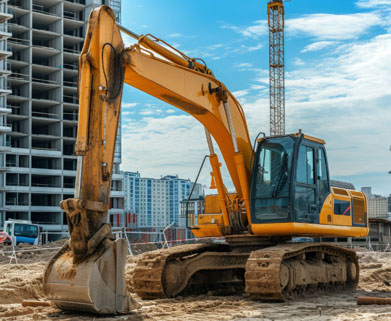Middle East Construction Equipment Market: Powering Growth with Innovation and Sustainability

The Middle East Construction Equipment Market is accelerating steadily, driven by the region’s expansive infrastructure projects and bold government initiatives. Valued at USD 16,110 million in 2024, the market is projected to rise to an impressive USD 21,178 million by 2030, growing at a compound annual growth rate (CAGR) of 4.95%. This growth underscores the dynamic transformation in the construction industry, fueled by technological advancements, rising urban development, and a growing focus on sustainability.
Market Growth Drivers and Regional Impact
The surge in construction equipment demand across the Middle East is primarily powered by flagship initiatives like Saudi Arabia’s Vision 2030, Qatar’s post-World Cup urban development, and extensive infrastructure spending across the Gulf Cooperation Council (GCC) nations. These projects range from futuristic smart cities such as NEOM to transportation network modernization like the Riyadh metro, along with tourism developments including the Red Sea project. These endeavors require a wide array of advanced construction machinery including earthmoving equipment, cranes, material handling machines, and road construction equipment.
Saudi Arabia leads the regional market, benefiting from massive investments and a forward-thinking regulatory environment fostering industrial growth. The country’s construction equipment market includes a broad spectrum of machinery tailored for complex infrastructure demands. Meanwhile, UAE, Qatar, Kuwait, Oman, and Bahrain complement this growth with their own ambitious projects, contributing to a thriving ecosystem for domestic and imported equipment sales.
Technological Advancements Shaping the Market
The Middle East construction equipment landscape is undergoing a technological revolution. There is an increasing adoption of hybrid and electric machinery, responding to growing sustainability mandates and regulatory pressures to reduce emissions. Furthermore, equipment is becoming smarter with integrated Internet of Things (IoT) and telematics technologies. These tools empower businesses to monitor equipment health in real-time, optimize fuel consumption, schedule predictive maintenance, and ultimately reduce downtime and operating costs.
Innovations such as AI-powered analytics and automation are transforming asset management practices, allowing companies to extend equipment lifecycles and enhance productivity. This shift towards smarter machinery also complements the growing demand for compact and versatile equipment designed specifically for urban construction projects where maneuverability and precision are paramount.
Rental and Leasing Models Enhance Accessibility
While the region’s construction equipment market is robust, the significant capital investment required for purchasing high-value machinery remains a barrier, especially for small and medium-sized enterprises (SMEs). To address this, rental and leasing models have gained considerable traction. These flexible procurement approaches enable contractors to access state-of-the-art equipment without heavy upfront costs, improving financial liquidity and operational scalability.
Rental rates vary depending on equipment type and capacity. For example, daily rentals for earthmoving equipment such as excavators and backhoe loaders typically range between USD 200 to USD 500, while larger machinery like bulldozers and cranes may command between USD 800 and USD 1,500. Such pricing models democratize access to advanced technology, empowering SMEs to participate actively in large-scale development projects and fostering a more inclusive construction ecosystem.
Segmental Insights: Earthmoving Equipment Leads
Among the various equipment types, earthmoving machinery remains the backbone of the regional market. Excavators, backhoe loaders, and wheel loaders equipped with IoT sensors and telematics are increasingly favored for their efficiency and cost-effectiveness. These machines facilitate critical tasks such as site preparation, excavation, and material transport across sprawling infrastructure projects.
There is also a marked trend towards fuel-efficient and environmentally friendly models, propelled by regulatory frameworks and corporate sustainability goals. The deployment of predictive maintenance through AI analytics helps minimize unplanned shutdowns, reducing operational disruptions and enhancing project delivery timelines.
Market Challenges and Opportunities
Despite the promising outlook, challenges persist. High acquisition costs limit access for many contractors, particularly smaller firms lacking favorable financing options. Additionally, the cumulative expense of insurance, maintenance, and technology integration can pose further financial strain. Nevertheless, the growing rental market is alleviating some of these pressures by providing flexible alternatives.
On the opportunity front, the region’s strategic localization efforts, including expanding service networks and spare parts availability, are key competitive advantages. These support structures boost equipment uptime and accelerate repair turnarounds, essential for executing time-sensitive projects. Furthermore, ongoing investments in infrastructure modernization and smart city developments promise sustained demand for advanced construction equipment.
Future Outlook
The Middle East Construction Equipment Market’s growth trajectory points to an industry reshaped by innovation, sustainability, and adaptive procurement. With a projected market value of USD 21,178 million by 2030, businesses that embrace cutting-edge technologies, leverage rental models, and align with regional development priorities will be well-positioned to capitalize on this dynamic market.
This comprehensive understanding of the Middle East Construction Equipment Market highlights a sector that balances tradition with innovation, capitalizing on the region’s ambitious development goals and emerging technologies to build the future’s infrastructure efficiently and sustainably.